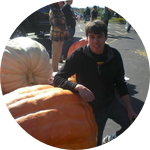About This Project
Giant pumpkins are horticultural marvels and are the product of decades of community-wide breeding and innovation. Very little is known about the genetic history of these giant squash strains and the DNA-level changes that have enabled their gargantuan size. The main objective of this study is to genetically characterize giant pumpkins and their wild ancestors using DNA sequencing. How has human selection shaped the genome of squash to produce the biggest fruit on earth?
Ask the Scientists
Join The DiscussionWhat is the context of this research?
The impact of selection on the variation of living organisms is an active area of scientific research. The power of selection can be readily seen in the development of giant strains of squash/pumpkins (C. maxima). For decades, passionate home gardeners and farmers have saved, and shared, seeds and pedigrees of their largest pumpkins leading to a dramatic increase in fruit size. Studies have indicated that this intense selection may have altered the sink capacity of squash leading to modern day behemoths (Salvage et al. 2015). With remnant seed from the giant pumpkin community, the recent availability of cucurbit genetic resources and cheaper DNA technology, we can now stand on the shoulders of these botanical giants and gain new insight into the impact of human selection on DNA.
What is the significance of this project?
Throughout human history we have altered the plants and animals around us to suit our needs through the process of domestication. In short, our ancestors selected on natural variation, observable differences, in their favorite plants and animals. Over time this selection process led to modern agricultural crops, livestock and companion animals. This process is epitomized in the development of giant pumpkins. By observing the changes in DNA that accompany selection we can better understand the processes that have shaped life around us and allowed us to feed our society.
What are the goals of the project?
Funds will be used to genetically profile giant squash strains identified from pedigree analysis, as well as some wild squash species. DNA will be extracted from seed embryo or seedling tissue, depending on the age of the seed, and sequenced. These genetic data will be used to help Infer the ancestors of modern day giant squash through building a family tree based on differences in DNA sequence. This information will also be used to characterize the diversity in modern giant squash strains, identify signatures of selection in the squash genome, and determine the relative roles of environment vs. genetics in driving fruit size. Results from this analysis will be shared in the form of a scientific publication and data will be disseminated through a publicly available database.
Budget
Some of the funds will be used for shipping of seed and/or tissue samples; however, the majority of funds will go towards DNA sample preparation and sequencing. All library prep and sequencing will be conducted at the Cornell University Genomics Facility following best practices for whole-genome skim sequencing.
 Project Timeline
Project Timeline
Seed samples will be obtained from growers and USDA stock. DNA extraction and quality control on 96 samples can be achieved within-in two weeks, but additional time is allocated in case some samples need to be re-extracted. Library prep and sequencing will be conducted by Cornell facilities within 2 months depending on the facility's work load. Three months will be allocated for data analysis and interpretation, followed by the preparation of a manuscript for publication.
Apr 30, 2020
Obtain diverse seeds from growers and USDA
May 31, 2020
DNA extraction and QC
Jun 30, 2020
Sequencing library preparation and QC
Jul 17, 2020
Sequencing
Aug 31, 2020
Data QC and variant calling
Meet the Team
Affiliates
Chris Hernandez
Chris is a Postdoctoral Associate with the Louisiana State University AgCenter, stationed in the Robbins Lab at Cornell University. He first become interested in plants and genetics through the hobby of giant pumpkin growing. He went on to receive his BS in Genetics and Agronomy at Iowa State University and a PhD in Plant Breeding from Cornell University, where his PhD work focused on using genomics to improve fruit quality traits in winter squash.
Jack Fabrizio
Jack is a PhD student in the Mazourek lab at Cornell University where he studies how to leverage genomics to breed for machine harvestability and fruit quality traits in chile pepper. For his undergraduate studies, he attended Oberlin College where he received a BA majoring in biology. His interest in plant genetics arose from working in an undergraduate laboratory chiefly concerned with phase dependent gene regulation as it relates to lateral root development. Jack looks forward to growing his first giant pumpkin in 2020.
Lab Notes
Nothing posted yet.
Project Backers
- 0Backers
- 0%Funded
- $0Total Donations
- $0Average Donation

